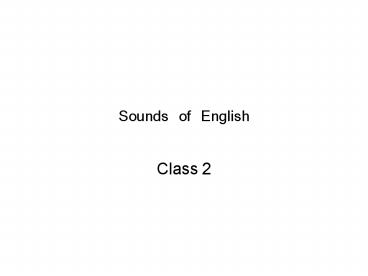Sounds of English - PowerPoint PPT Presentation
1 / 32
Title: Sounds of English
1
Sounds of English
- Class 2
2
Sounds of English
- Consonants first, the stops
- b as in bat, sob, cubby
- d as in date, hid, ado
- g as in gas, lag, ragged
- p as in pet, tap, repeat
- t as in tap, pet, attack
- k as in king, pick, picking
When we need to emphasize that we are using a
phonetic transcription, we put square brackets
b around the symbols.
3
More consonants fricatives
- f as in fail, life
- v as in veil, live
- O as in thin, wrath
- ð as in this, bathe
- s as in soft, miss
- z as in zoo, as
- (American) or ? (IPA) as in shame, mash
- (American) or ? (IPA)as in triage, garage,
azure, - h as in help, vehicular
4
affricates
- c (American) or t? (IPA) as in cheap, hatch
- j (American) or ? (IPA) as in jump, hedge
5
nasal consonants
- m as in map, him
- n as in knot, tin (alveolar POA)
- ñ as in canyon
- ? as in sing, gingham, dinghy
6
Liquids
- l as in large, gull
- r as in red, jar
7
glides and semi-consonants
- j (IPA) as in boy, yellow
- w as in wall, cow
8
- 6 stops
- 2 affricates
- 9 fricatives
- 4 nasals
- 2 liquids
- 2 glides
9
Short vowels
- Front vowels
- I as in bit
- ? as in bet
- æ as in bat
- Back vowels
- U as in put
- ? as in putt
- ? as in bought
- a or ? as in Mott, ma, spot
- ? schwa as in about
10
Long vowels
- ij or i as in beet
- ej as in bait
- aj as in bite
- oj as in boy
- uw or u as in boot
- ow as in boat
- aw as in how
11
Not all Americans talk the same way
- Some people do not have a contrast between ?
and a - cot versus caught
- Sean versus Connery.
- There are (interesting) details we are ignoring,
like the difference between the vowel in cat and
that in sand, for most Americans. - There are far more differences than that, of
course!
12
Review where weve been
- Weve listened to the sounds of our English,
and assigned a set of symbols to them. - We abstracted away from pitch, loudness, and
duration. - We hope to better understanding our languages
sounds by analyzing them as being composed of a
sequence of identifiable sounds, each of which
occurs frequently in words of the language.
13
Consonants
- Consonants obstruents sonorants
- Obstruents (oral) stops, affricates, and
fricatives - Sonorants nasals and liquids (l,r)
14
Consonants
- Consonants can be defined by
- Point of articulation (or place)
Specification of the active and passive
articulators. - Manner of articulation
- Oral stop nasal stop fricative affricate
lateral flap approximant and some others.
15
Consonants have a point of articulation
- The crucial points of articulation for English
consonants are - Labial
- Labio-dental
- Dental
- Alveolar at the alveolar ridge, behind the teeth
- Post-alveolar/palato-alveolar/alveopalatal
multiple names for the same thing - Retroflex (r only)
- Palatal (y, ñ)
- Velar
- Laryngeal
16
Places of articulation labial
- Bilabial made with two lips
- (pie, buy, my)
- Labiodental lower tip and
- Upper front teeth (fie, vie).
Slide from Liberman and Yuan
17
Places of articulation coronal
- Dental tongue tip or blade and upper front teeth
(thigh, thy). (interdental the tip of the tongue
protrudes between the upper and the lower front
teeth). - Alveolar tongue tip or blade and the alveolar
ridge (tie, die, nigh, sigh, zeal, lie). - Retroflex tongue tip and back of the alveolar
ridge (rye, row, ray). - Palato-Alveolar (post-alveolar) tongue blade and
the back of the alveolar ridge (shy, she, show).
Slide from Liberman and Yuan
18
Places of articulation dorsal
- Palatal front of the tongue and hard palate
(you). Palatal sounds are sometimes classified as
coronal. - Velar back of the tongue and the soft palate
(hack, hag, hang).
Slide from Liberman and Yuan
19
Oro-nasal process
From Dan Jurafsky slide
Oral sounds soft palate is raised (closing the
passage).
Nasal sound soft palate is lowered, so air
passes through the nose.
20
Manners of articulation
- Stop
- Fricative near closure, creating frication
(heavy air turbulence) - Affricate (combined stop and fricative)
- Approximant (no turbulence) (y,w,r)
- Lateral approximant (l) obstruction in the
middle, air passage around the side of the
tongue. - Tap or flap American symbol D, IPA ?
21
- Obstruents
- 6 stops
- 9 fricatives
- 2 affricates
- Nasals (4)
- 2 other sonorants (what are they?)
- 2 glides
22
(No Transcript)
23
Vowels
- Vowels are harder to characterize articulatorily,
but we try! - The fact that its harder is reflected in the
fact that there is more than one way in which
its done. IPA is one way American is another.
24
- Vowels are displayed in a two-dimensional chart,
corresponding only roughly to the position of the
tongue, and the first two formants of the vowel. - Plus whether the lips are rounded
- Monophthong or diphthong (no movement, or
movement)
25
From Jennifer Venditti slide
26
IPA
27
Two systems side by side
28
the end
29
A phonetic chart based on the first two formants
30
From http//hyperphysics.phy-astr.gsu.edu/hbase/m
usic/vocres.html
31
/i/ green
/ae/ hat
/u/ boot
graphics thanks to Kevin Russell, Univ of
Manitoba
32
Hi /haj/
FORMANTS
we were away a year ago































